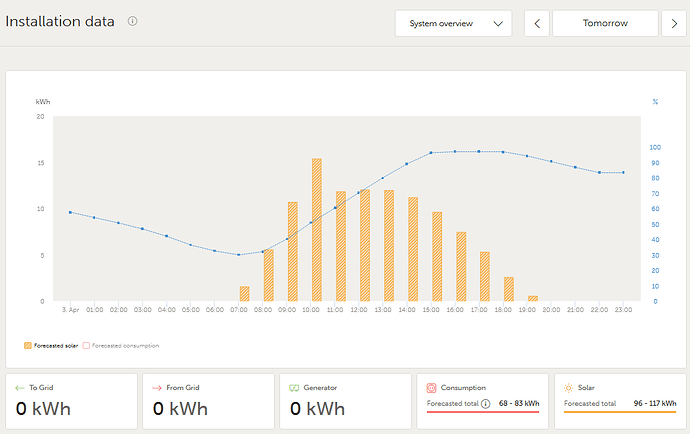I explained to you why this is related to your north-facing system and the specific weather conditions of the last few days. Give the system a few days. One more thing… the system changes its forecasts every 15 minutes. Mine has also gone up and down by a factor of 2-3 over the last few days. That was due to the regional weather. I’m very dependent on the weather for my job and have several weather forecasts, including professional ones. None of them have been regionally accurate over the last two days. Sometimes a cloud band moving a few kilometers differently or high fog that doesn’t clear up can have serious consequences for the PV.
Na I do not believe the learning theory I do believe that I/we got maybe an update (or more likely accidentely correct):
Now I see the forecast as a range the first time.
and yes the energy forecast did go up and down by factors but the irridiation forecast not (here at least). If the irridiation is pretty stable the energy forecast should be as well - that’s why I believe it is a bug they maybe are working on.
But lets move from believing to facts again:
Energy forecast for tomorrow 135-165:
Irridiation forecast:
So roughly 2.x (realistic) to 4 (very optimistic) times of todays actuals. Means we should end up at ~55-80kWh tomorrow - VRM states 135-165kWh. Lets see who is right my super simple way or VRMs algo.
update next morning VRM has slightly reduced the forecast for today 27.03
Similar Irridiation
but
to 128-156kWh
Result 43,8kWh
Irradiantion result
So “I” was to optimistic by 25% but VRM by factor 3. Irradiation has changed but not dramatically.
Last day then a pause for min a week.
Today it should be sunny
But that sunny? 207kWh min?
Irradiation:
I would assume ~40% more than yesterday so I am guestimating a solar engery output of ~61kWh today (most likely bit less).
Update with the result: 52.2kWh
“I” was 15% to optimistic. VRM by factor 4 wrong. I really would like to understand what Victron is calculating.
So several days later - the forecast for today
taken yesterday evening - super optimistic 96kWh
and from this morning - more on the pessimistic side 41kWh
Comsumption forecast has not changed but solar has changed a lot over night - no weather forecast is stable showing blue sky!
My forecast would be 55-65kWh (733 yesterday today 744W/sqm peak and yesterday we had 62kWh but it will be warmer so less efficient)
The forecast in the early morning seems now to be much better then the evening of the day before which looks no longer that bad (factor 3-10) instead 1.5-2 wrong. Why there is such a huge difference I cannot understand - looks like completely different algos.
Real result will be added this evening.
Here it is 58,6kWh:
Wait a few days, and your consumption forecast will adjust to your actual consumption. This works very reliably.
Consumption forecast works as expected even though it is far more difficult to forecast the consumption than the solar.
Solar for today forecasted yesterday evening 143kwh
this morning 32kWh
My forecast (simply taking the irridiation forecast and rule of three) is ~59kWh as irradiation (weather) today should be similar as yesterday. Picture taken yesterday evening
Why are both values (evening of yesterday and morning today) sooo different. It also looks like the better the weather the bigger the difference. Still my conclusion they are using different algorithm for both and both are not working as they should and it seems no one wants/can transparently explain how it is done.















